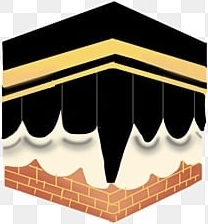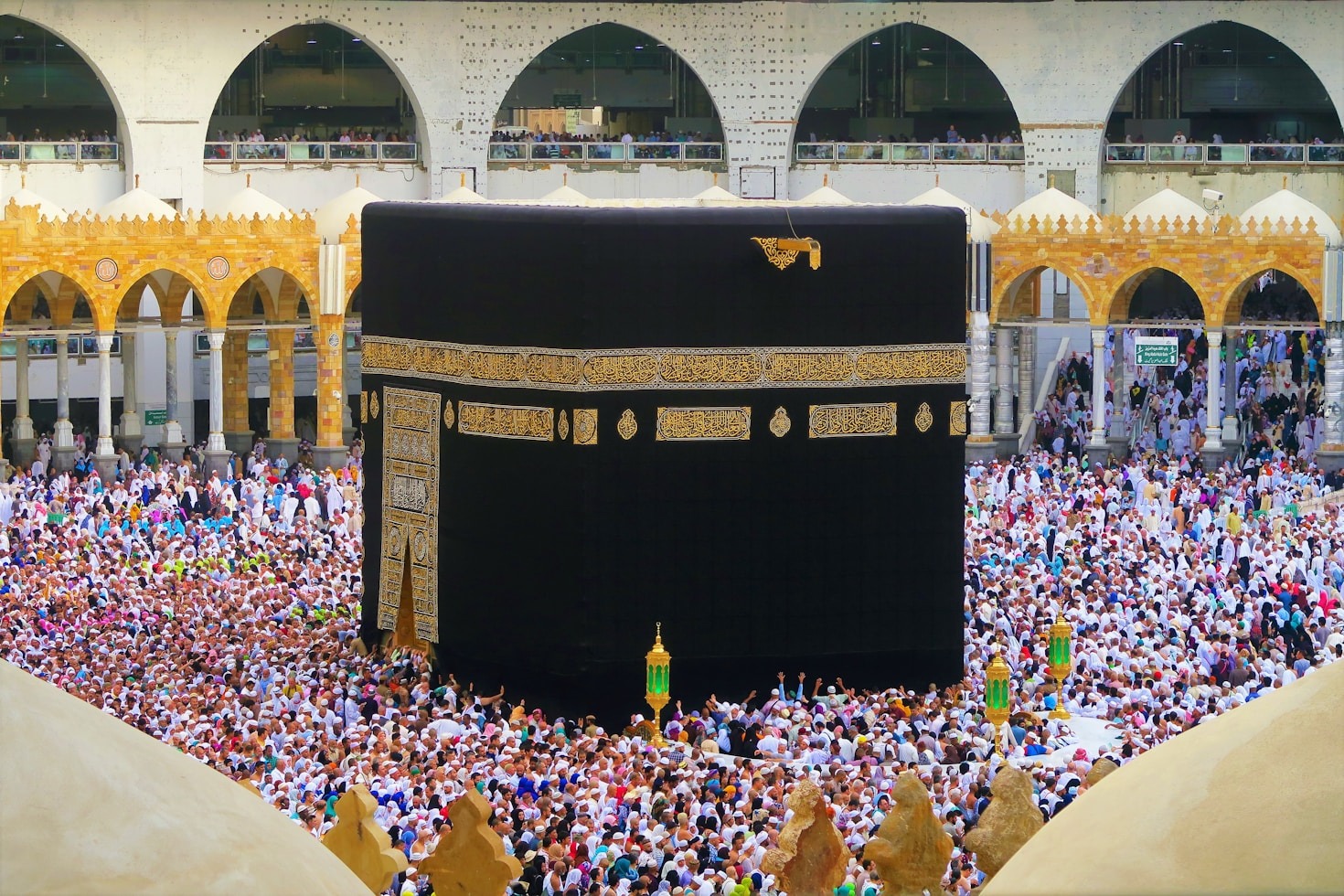The Holy Kaaba: All You Need to Know About the House of Allah
The Holy Kaaba stands as the most revered site in Islam, symbolizing unity and devotion for Muslims globally. Situated at the center of the Masjid al-Haram in Mecca, Saudi Arabia, the Holy Kaaba serves as a central point for Islamic worship. This sacred edifice is also referred to as the ‘Baitullah Sharif’ or the ‘House of Allah’.
The construction of the Kaaba holds significant importance in Islamic history. It is believed that Prophet Ibrahim (AS) and his son, Prophet Ismail (AS), constructed it as a place of worship for the One True God- Allah (SWT). This hallowed structure has been integral to the Muslim faith throughout the ages.


The Kaaba is of immense spiritual significance as the Qibla, the direction that Muslims orient themselves towards during their daily prayers (Salah). This common direction of prayer unites Muslims, fostering a sense of brotherhood and equality. Regardless of their location around the globe, Muslims collectively bow in reverence and submission to the Almighty. In this blog, we will explore this sacred structure and various related topics.
History and Formation of Holy Kaaba
The Holy Kaaba possesses a profound history that extends back to pre-Islamic times when it was not widely recognized. According to Islamic tradition, the structure was initially constructed by Prophet Ibrahim (AS) and his son, Prophet Ismail (AS). Following the command of Allah (SWT), they built the Holy Kaaba as a straightforward, unroofed rectangular edifice dedicated to the worship of the Divine.
Around 608 C.E., the Quraysh tribe, who governed Mecca, reconstructed the Islamic Kaaba utilizing alternating layers of masonry and wood. To safeguard the shrine from intruders and floodwaters, they elevated the door above ground level.
When Prophet Muhammad (PBUH) was forced to leave Mecca in 620 C.E., he moved to Yathrib (now known as Medina). Upon his victorious return to Mecca in 630 C.E., he made the Holy Kaaba the central place of worship and pilgrimage for Muslims. During this time, the pre-Islamic Kaaba housed the Black Stone and statues of pagan gods. Muhammad (PBUH) cleansed it of these idols, restoring its status as a symbol of worshipping the one Allah (SWT) as intended by Ibrahim.
Later the Prophet (PBUH) established the rites of pilgrimage during his final pilgrimage in 632 C.E., the year of his death, solidifying the Islamic Kaaba’s significance in Islam.
Where is the House of Allah?
The House of Allah, known as the Holy Kaaba, is located in the holy city of Makkah, Saudi Arabia. It is situated within the Masjid al-Haram, the largest mosque in the world.
Changes of the Holy Kaaba with Time
The Holy Kaaba has undergone many changes throughout its history. The second caliph, ‘Umar, expanded the area around it to accommodate more pilgrims between 634-644. The next caliph, ‘Uthman, added colonnades around the open plaza where the Kaaba stands and included other important monuments in the sanctuary.
In 683 C.E., during a civil war, the Kaaba was set on fire. The Black Stone broke into three pieces, which Ibn Zubayr reassembled with silver. With the wood and stone, He rebuilt the structure following the original dimensions and made a space around it. When Abd al-Malik regained control of Mecca, he restored the parts of the building that were designed during Prophet Muhammad’s (PBUH) time.
Later, during the reign of Umayyad caliph al-Walid (705-715), the mosque surrounding the House of Allah was adorned with mosaics akin to those found in the Dome of the Rock and the Great Mosque of Damascus.
The Abbasid caliphs (750-1250) made several expansions and modifications to the mosque around this sacred site. From 1269 to 1517, the Mamluks of Egypt governed the area and constructed a religious school adjacent to the mosque. The Ottoman sultans, Süleyman I and Selim II, undertook significant renovations of the complex. In 1631, following a flood, the Islamic Kaaba and the mosque surrounding it were entirely rebuilt. The mosque that stands today features a vast open area with colonnades on all four sides and seven minarets.
The most recent major renovations occurred in the 1950s, carried out by the Saudi Arabian government to better serve the increasing number of pilgrims.
Kiswa: The Black Cover on the Kaaba
The covering of the Holy structure is known as Kiswa. After the conquest of Makkah in the ninth year of Hijri, Prophet Muhammad draped the Kaaba with Yemeni fabric during his farewell pilgrimage. Nowadays, the Kiswa, which is the black covering of the Kaaba, is replaced every year during Hajj. This replacement takes place after the pilgrims ascend Mount Arafat, preparing the Kaaba to welcome worshippers on Eid Al-Adha.
Over the years, the Kiswa has undergone various transformations. Initially, Prophet Muhammad (PBUH) used a white-and-red striped Yemeni cloth. His companions, Abu Bakr Al-Siddiq, Umar ibn Al-Khattab, and Uthman ibn Affan, later covered it with white fabric. Ibn Al-Zubayr opted for a red brocade for the cover.
During the Abbasid period, the Kiswa alternated between white and red, while the Seljuk Sultan adorned it with yellow brocade. The Abbasid Caliph Al-Nassir later transformed its color to green and subsequently to black brocade, a practice that remains in place today.
The Kiswa features Quranic verses embroidered in silver and gold thread, enhancing its beauty and importance. These elaborate designs elevate the Kiswa beyond a mere covering, turning it into a piece of art that embodies the reverence Muslims hold for the Kaaba.
Why is the Kaaba referred to as Allah’s House?
The Kaaba is known as Allah’s House because it stands as the holiest site in Islam, constructed as a place of worship dedicated exclusively to the One True God – Allah (SWT). Muslims believe that it was initially built by Prophet Ibrahim (AS) along with his son, Prophet Ismail (AS).
Key Features of the Holy Kaaba
The Holy Kaaba, situated at the heart of the Masjid Al-Haram in Makkah, is the most sacred location in Islam. Below are the key features of this venerated structure:
The Black Stone (Hajar al-Aswad)
The Black Stone is embedded in the eastern corner of the Kaaba. Muslims believe it was sent from paradise. Pilgrims strive to kiss or touch the stone during Tawaf (circumambulation), following the example set by the Prophet (PBUH).
The Door (Bab al-Kaaba)
The Kaaba boasts a door crafted from gold, positioned approximately 2.2 meters above the ground on the northeastern wall. This entrance is reserved for select individuals during special events.
The Gutter (Mizab al-Rahmah)
The Mizab al-Rahmah, or The “Gutter of Mercy” is a gold-plated spout located on the roof of the Kaaba, designed to drain rainwater and symbolizes the mercy of Allah flowing into the world.
The Hatim
The Hatim is a semi-circular wall situated opposite the northwestern wall of the Kaaba. It is thought to delineate the boundary of the original Kaaba constructed by Prophet Ibrahim (AS) and his son Ismail (AS). It is highly recommended to pray within the Hatim, as it is regarded as part of the Kaaba.
The Station of Ibrahim (Maqam Ibrahim)
Positioned near the Kaaba, the Maqam Ibrahim is a stone that marks the spot where Prophet Ibrahim stood during the construction of the holy edifice. It bears the imprint of his feet and is encased in a glass and metal structure. After completing the Tawaf, Muslims pray behind it.
The Corners
The Kaaba features four corners, each aligned with a cardinal direction: the Black Stone corner (east), the Yemeni corner (south), the Syrian corner (north), and the Iraqi corner (west). Each corner holds its own significance, particularly the Black Stone and Yemeni corners, which are touched during the Tawaf.
The Multazam
The Multazam refers to the area situated between the Black Stone and the door of the Kaaba. It is believed to be a place where prayers are particularly answered, and pilgrims often cling to this area in search of blessings and forgiveness.
These components of the Kaaba, each with its unique history and importance, collectively establish it as a central point of Islamic worship and devotion. The structure of the Kaaba and its elements symbolize the unity and sanctity of the Muslim Ummah, attracting millions of pilgrims from across the globe.
Inside the Holy Kaaba
The interior of the Holy Kaaba is unadorned yet possesses profound spiritual significance. Below is an overview of what exists within this sacred structure:
Three Pillars
Within the Kaaba, there are three wooden pillars that provide support for the roof. Constructed from sandalwood, these pillars have stood for centuries. They are arranged in a triangular formation, ensuring a stable support system for the roof.
Inner Walls and Floor
The inner walls of the Kaaba are covered with

